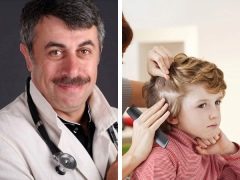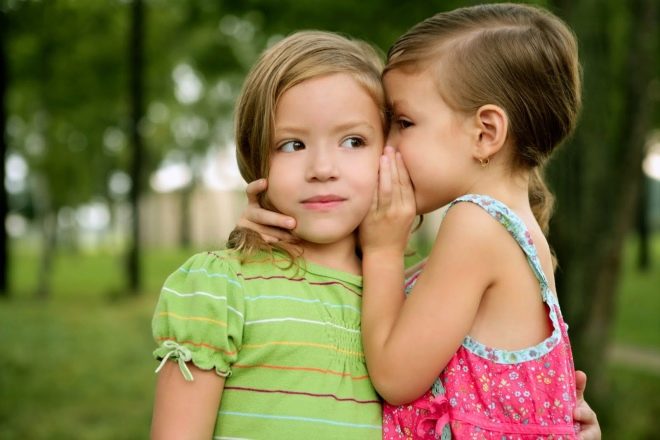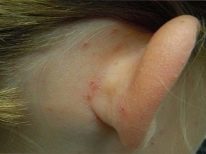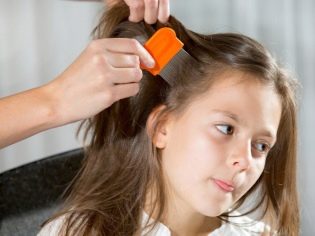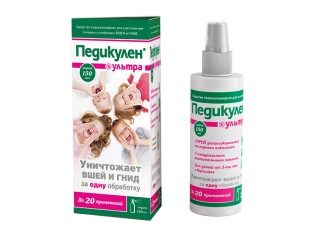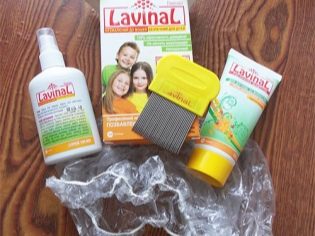Dr. Komarovsky about what to do if a child has lice
Modern parents often mistakenly believe that lice is a disease from the past, but today, especially in children's groups, pediculosis is very developed, and therefore there is nothing surprising that your well-groomed and clean child will bring lice from school or kindergarten in one day.
Children's doctor Komarovsky talks about what you need to pay attention to, how to act and how to treat lice to quickly cope with the problem.
Causes and symptoms of pediculosis
Before talking about how to deal with lice, you need to clearly understand who they are and where they come from. Pediculosis is a parasitic skin disorder that is caused by three types of parasites: wrist, hair and pubic lice. The most common in childhood - hair lice, and it is them most often brought by children from children's groups.
Lice feed on human blood, eggs are laid in the same place where they feed. In the case of hair lice - on the head, in the hair. Lice - one of the oldest inhabitants of the planet, they exist on Earth for more than 80 thousand years.
According to statistics, most often pediculosis is detected in children, in a certain age group - from 4 to 14 years. In this case, the more often a child washes his head, the more likely it is that he will become infected with a parasitic ailment, since louses are fastened faster on clean hair, become habitable, and begin to host.
Incredibly and almost inexplicably, but most often lice are brought from kindergarten and school by children who are characterized by increased nervous excitability. Some scientists believe that stress hormones subtly change the smell of the human body for the human sense of smell - it becomes more attractive for blood-sucking parasites.
A child can become infected only from another person; there is no other way to transmit lice.. At the same time, according to Komarovsky, lice for long distances can not run and jump, so usually infection becomes possible through head-to-head contact.
Parents may not notice anything during the incubation period, and it lasts from a week to a week and a half.
Then the characteristic symptoms will appear: the baby is scratching his head, on closer examination, the areas that the child has combed are visible on the skin. Around such places there are small gray dots. On the hair in the root zone, parasite eggs (nits) can be visible - they are round, white or yellow.
Adult lice are best seen on the hairline above the temples, in the ear region and on the back of the head closer to the neck.
Parenting
If a child has lice, leave it unattended. The treatment is simple and quick, but it is important to prevent the recurrence and spread of parasites in the teamand therefore without false shame and fear parents must immediately notify the teacher or class teacherto therapeutic and preventive measures were carried out comprehensively.
Treating lice at home, responsibility - on parents. It is necessary to destroy not only all adults, but all nits, otherwise the disease will recur after a certain time.
If permethrin-based drugs effectively fight adults, the nits will have to be combed and removed manually, since many of them are fully capable of surviving a pharmacological attack and retaining their viability.
Lice comb doctor recommends metal combs with very frequent small teeth like plastic combs are designed to prevent.
There is no need to cut or shave a child today. Available farmsredstva quite able to cope with the task without a preliminary haircut.
The baby’s clothes and bedding should be boiled, washed and dried in the open air, preferably in the sun or on the open balcony, which is well ventilated. Dry underwear is recommended to iron carefully.
The child during the treatment should not attend classes, go to workouts, walk in the yard with other children. Visiting stores and other crowded places is not recommended. Quarantine should last at least three days after the start of treatment..
If you improperly or insufficiently treat a child, the consequences can be quite serious - lice, like blood-sucking, suffer dangerous diseases, the child can get recurrent typhoid fever, and scratching on the skin can become infected with fungi, bacteria and lead to inflammatory diseases.
After processing the head according to the instructions for the preparation, it is important to teach the child not to cuddle when communicating with his head to his classmates and friends, not to give to others, and not to take earphones, hats, and combs from other children.
It will be good if the outerwear of the child is sewn from fabrics to which the parasites cling most difficultly (this method of transmission can occur if the clothes of an infected child are in the same dressing room in close contact with the clothes of other children). Komarovsky considers modern cloak fabrics the best fabric.
How to treat?
It is necessary to approach the choice of a preparation as seriously as possible, after all the majority of such means are toxic. The use of drugs should be carried out in strict accordance with the instructions.
Komarovsky strongly advises not to treat lice folk remediesSince kerosene and vinegar are often ineffective, and harm to a child can be no less than the inept use of pharmaceuticals. So you need to go to the pharmacy, buy medicine and use it wisely - the only way to quickly get rid of unpleasant blood-sucking parasites.
In the pharmacy, two types of drugs are waiting for you - the first ones (based on permethrin) affect the nervous system of lice. The second preparations are based on mineral oils or dimethicone - they act mechanically on the lice - they block the respiratory system, causing the parasites to die.
Younger children are suitable drugs of the second type. For natural plant and mineral remedies (the very second group) include “Paranit” (shampoo, spray, repellent and lotion), “Paranit Sensitive” - the same, but for kids up to 3 years old, “Pediculen ultra” (spray and lotion ), "Avalanche" (shampoo, spray). The group containing permethrin preparations "Para plus" (aerosol), "Knicks", "Medifox" (gel, concentrate for the preparation of the emulsion), "Avitsin", "Pedilin" and several others.
Rules for the use of these drugs do not imply free access of children to these drugs. If after two uses of the product there is no result or it is insufficient, you need to change the drug.
Do not think that if you mix several funds from lice, then the result will be more pronounced.
Means during processing should not fall into the eyes, nose and mouth. If this happens, rinse the affected area without panic. If the child took a sip of the drug, you need to call an ambulance, and while the doctors are going, try to wash the stomach with your own efforts.
More on the problem of pediculosis in children Evgeny Komarovsky tells in this video.
